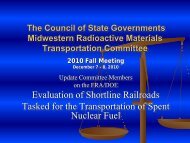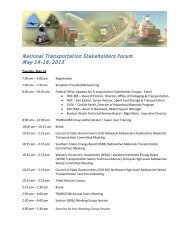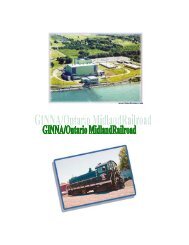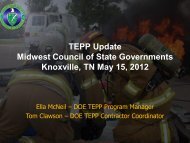Stateline Midwest - CSG Midwest
Stateline Midwest - CSG Midwest
Stateline Midwest - CSG Midwest
You also want an ePaper? Increase the reach of your titles
YUMPU automatically turns print PDFs into web optimized ePapers that Google loves.
Cover STORy<br />
CONTINUED FROM page 1<br />
Concerns about pipeline lead to new siting laws in Nebraska and rerouting of project<br />
Quality.<br />
In Minnesota, North Dakota and South Dakota,<br />
the states’ public utilities commissions have the<br />
authority to approve or deny applications to construct<br />
crude oil pipelines. (South Dakota granted a permit<br />
for Keystone XL in 2010, contingent on TransCanada<br />
meeting 50 different conditions; the pipeline route<br />
did not run through Minnesota and North Dakota.)<br />
Nebraska, though, had no such processes in place<br />
— until November.<br />
The new laws approved during the special session<br />
will establish a siting permit process for the state<br />
while also authorizing and funding an environmental<br />
impact study of TransCanada’s proposed pipeline.<br />
“From the beginning, I sought a process similar to<br />
what neighboring states have to determine the route of<br />
oil pipelines,” says Nebraska Sen. Annette Dubas, who<br />
helped push for the special session and served as the<br />
sponsor of the Major Oil Pipeline Siting Act, LB 1.<br />
Under this new law, the Nebraska Public Service<br />
Commission has the authority to evaluate and approve<br />
applications to site major oil pipelines in the state. The<br />
applicant will have to pay any costs associated with<br />
public hearings and state investigations.<br />
LB 1 also sets time lines for the commission to<br />
make a decision — seven months upon receipt of the<br />
application, though the commission could extend that<br />
time period by another five months for “just cause”<br />
— and requires a company to have an approved application<br />
before it is given eminent domain rights.<br />
This new state law, though, will not apply to any<br />
new rerouting plan for TransCanada’s Keystone XL<br />
project. The Legislature instead crafted a second bill<br />
to deal with that project.<br />
Under LB 4, the state Department of Environmental<br />
Quality will conduct a $2 million environmental<br />
impact study (paid for by the state) and prepare<br />
recommendations to the governor, who will then<br />
notify the federal government whether the state<br />
approves or disapproves of the new route.<br />
Long route for pipeline approval<br />
The special session in Nebraska put the state<br />
at the center of an international controversy<br />
over the pipeline and the use of oil from the<br />
province of Alberta’s oil sands.<br />
Haar says his constituents have not necessarily<br />
been against tapping into the oil sands or even building<br />
a new pipeline through Nebraska. (An existing<br />
Keystone pipeline, in fact, already runs through the<br />
state). What they didn’t like was the proposed route.<br />
But outside of Nebraska, opponents of the<br />
project have been asking another question: Should<br />
a pipeline transporting oil<br />
from Alberta’s oil sands to<br />
this country be built at all?<br />
That question will be<br />
debated for at least another<br />
year even if a new<br />
route addresses Nebraska’s<br />
specific concerns about<br />
potential contamination of<br />
the Ogallala Aquifer.<br />
Sen. Annette Dubas<br />
Opponents say the<br />
pipeline will take the U.S.<br />
on the wrong energy path:<br />
a greater use of fossil fuels (the oil sands, in<br />
particular, have been criticized because of the<br />
amount of greenhouse gases emitted during the<br />
recovery process) and an abandonment of efforts<br />
to reduce the country’s carbon footprint.<br />
Keystone oil pipeline in the <strong>Midwest</strong><br />
From oil sands<br />
in Alberta<br />
To refineries in<br />
Oklahoma and Texas<br />
Existing Keystone pipeline<br />
Proposed Keystone XL expansion*<br />
* TransCanada has agreed to work with the state of Nebraska on an<br />
alternative route that addresses concerns about the proximity of the<br />
proposed Keystone XL project to the Sandhills region and the Ogallala<br />
Aquifer.<br />
Source: <strong>CSG</strong> <strong>Midwest</strong> map (using information from TransCanada)<br />
TransCanada officials say they have been surprised<br />
at the level of opposition to the project.<br />
“Four years ago, we thought it would be embraced<br />
with great enthusiasm,” Scott Farris, director of<br />
government relations for TransCanada, said during<br />
a policy session in October at The Council of<br />
State Governments’ National Conference & North<br />
American Summit.<br />
The first two phases of the<br />
pipeline project had already<br />
been completed without resistance,<br />
he said, and the proposed<br />
Keystone XL expansion would<br />
bring additional jobs and reduce<br />
U.S. dependence on oil from<br />
more-hostile parts of the world.<br />
The first part of the pipeline<br />
project received a permit in less<br />
than two years. (That permit was<br />
approved by President Bush in<br />
2008.) In contrast, TransCanada<br />
submitted its application for<br />
Keystone XL in September 2008<br />
and will now have to wait until<br />
at least 2013 for a final decision<br />
on the presidential permit.<br />
The Obama administration<br />
cited recent developments in<br />
Nebraska as the reason for the<br />
delay, but the decision was also<br />
expected to be politically difficult,<br />
in part because the decision<br />
split union and environmental<br />
groups.<br />
The National Wildlife<br />
Federation, for example, says the proposed expansion<br />
is a “game-changer” that would “lock the U.S. into a<br />
dependence on this dirty fuel and drive a massive<br />
expansion of the tar sands operations in Alberta.”<br />
Key unions, meanwhile, have hailed the project’s<br />
“game-changing economic benefits”: more<br />
jobs and state and local tax revenue. TransCanada<br />
has said the expansion would create 20,000 U.S.<br />
jobs in construction and manufacturing, as well<br />
Crude oil production<br />
in <strong>Midwest</strong> vs. amount<br />
imported into U.S. from<br />
Canada (2010)*<br />
State<br />
as additional jobs for communities along<br />
the pipeline route.<br />
Pipeline through 6 <strong>Midwest</strong> states<br />
The first presidential permit allowed the<br />
construction of an oil pipeline from Alberta<br />
to refineries in the Illinois towns of Wood<br />
River and Patoka.<br />
That pipeline, which runs through six<br />
<strong>Midwest</strong>ern states — North Dakota, South<br />
Dakota, Nebraska, Missouri and Illinois —<br />
became operational in 2010. A second phase<br />
of the project was up and running in 2011; it<br />
extends the pipeline to storage and distribution<br />
facilities in Oklahoma.<br />
The goal of an additional pipeline expansion<br />
— the Keystone XL project — is to create<br />
a new route carrying oil from Alberta’s oil<br />
sands to Port Arthur, Texas. It would dramatically<br />
increase the amount of oil that could be<br />
shipped to and used in the U.S.<br />
The new pipeline would also transport<br />
oil produced in Montana, North Dakota and<br />
South Dakota; according to TransCanada<br />
spokesman Shawn Howard, about 25 percent<br />
of the oil carried in the pipeline would come<br />
from those states.<br />
In all, the pipeline could transport up to 830,000<br />
barrels of oil a day.<br />
Regardless of whether Keystone XL is built,<br />
Canadians will not sit on such a valuable energy<br />
resource. Some Canadian officials, including federal<br />
finance minister Jim Flaherty, have said that Canada<br />
could also look toward other pipeline options and<br />
export markets for the oil sands.<br />
Thousand<br />
barrels per<br />
day<br />
U.S.<br />
rank<br />
Illinois 25 14<br />
Indiana 5 22<br />
Kansas 111 9<br />
Michigan 18 16<br />
Nebraska 6 21<br />
North Dakota 310 4<br />
Ohio 13 18<br />
South Dakota 4 25<br />
<strong>Midwest</strong> total 492 —<br />
Crude oil imported into<br />
1,929 —<br />
U.S. from Canada<br />
* The U.S. Energy Information Administration reports that the<br />
<strong>Midwest</strong> was home to eight of the 31 oil-producing states in<br />
the United States in 2010. The state data and rankings do not<br />
include offshore production. Canada is the leading supplier<br />
of crude oil imports to the United States, accounting for 21<br />
percent of the total.<br />
Source: U.S. Energy Information Administration<br />
Flaherty told Bloomberg News<br />
that one possibility would be<br />
to build a pipeline to British<br />
Columbia for export to Asia.<br />
As pipeline proponents<br />
have noted, too, Canada is a<br />
friend, neighbor and stable<br />
democracy — qualities that<br />
aren’t necessarily true of some<br />
other countries from which the<br />
U.S. gets its oil.<br />
“When a nation [like the<br />
United States] imports three<br />
times more energy than it produces,<br />
it makes sense to go<br />
next door to borrow a cup of<br />
sugar or borrow a million barrels<br />
of oil a day,” Murray Smith, a<br />
former member of the Alberta<br />
legislature who now works in<br />
the private energy sector, told<br />
legislators at the <strong>CSG</strong> summit.<br />
Canada, in fact, already is<br />
the leading supplier of U.S. oil<br />
imports (21 percent of the total),<br />
with the oil sands accounting for<br />
170 billion barrels of Canada’s<br />
176 billion barrels of proven reserves. Another 315<br />
billion barrels could potentially be captured with<br />
advances in technology and the recovery process.<br />
Whether the U.S. decides to use more of that<br />
oil remains to be seen. But as the recent special<br />
session in Nebraska shows, any pipeline project<br />
will likely need the backing of all states along the<br />
proposed route.<br />
6 STATELINE MIDWEST December 2011








